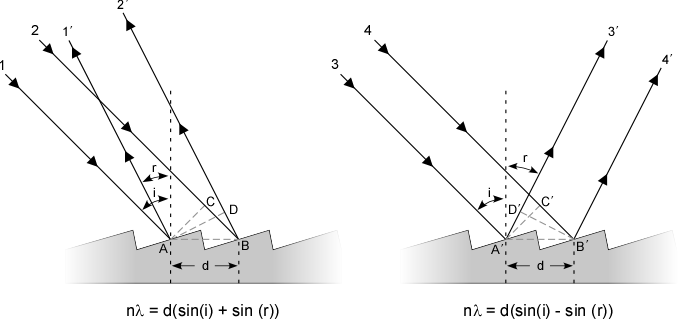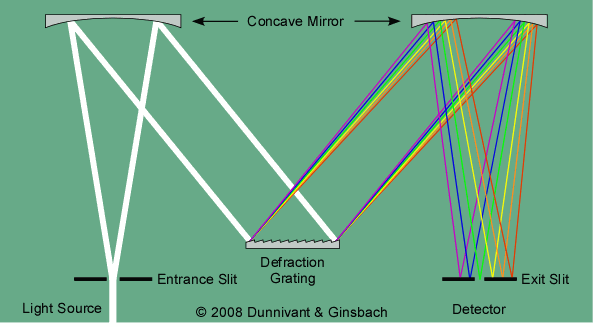2.2 Components of a Flame Atomic Absorption/Emission Spectrometer System
2.2.8 Monochromators
As discussed in Chapter 1, a monochromator is a device that is used to separate wavelengths of light through dispersion. There are two types of monochromators: prisms and grating systems. Despite achieving the same goals, as noted in Chapter 1 prisms and grating systems separate various wavelengths of light in different fashions. Prisms refract light at the interface of two surfaces with differing refractive indexes creating angular dispersion. Historically, prisms were the first monochomators to be developed, but they have limitations. Their resolution is significantly lower than a grating system and their separation technique is non-linear (with respect to distance along the exit slit) which creates mechanical problems with focusing a specific wavelength on the exit slit. The one advantage that prisms possess over grating systems is their low manufacturing cost.
Diffraction gratings are materials with a large number of parallel and closely spaced slits or ridges. Diffraction causes constructive interference at unique points for each wavelength. In Section 1.3.5 the theory behind the two governing equations for diffraction yielding constructive interference was described by
![]()
with each of the variables shown again in Figure 2-4. Despite their higher cost grating monochromators are used in all modern medium- to high-end spectrometry systems.

Figure 2-4 Diffraction Resulting from a Typical Echellette-Type Grating.
This equation was simplified for an Echelle style grating to
![]()
The first grating monochromators used were of the Czerney-Turner style illustrated in Figure 2-5. This common form of monochromator was used for decades when PMTs (Section 2.2.9) were the detector of choice. UV and visible wavelengths enter the monochromator through an entrance slit where they are reflected onto the grating device where spectral separation occurs. The separated wavelengths were collimated (focused by wavelength) with a concave mirror toward the exit slit. The tilt angle of the grating device determined the band of wavelengths exiting the monochromator and reaching the detector: usually a photomultiplier tube (PMT).
Today, with the replacement of PMTs in higher-end instruments by more modern microelectronic circuitry (charge transfer and injection devices described below), only an entrance slit is necessary. In some higher-end AAS and AES units, newer monochromator/detector systems have an Echelle grating monochromator and charge transfer device placed together where all wavelengths are measured simultaneously with a charge transfer device without the need for an exit slit (illustrated in the next section). This can also be used in absorption spectrometry where individual source lamps are required (only one element is still detected at one time), but is mostly of importance in emission spectrometry where all elements present in the sample cell are undergoing wavelength specific relaxations.

Figure 2-5 A Czerney-Turner Style Grating Monochromator. Note that only two diffracted beams of light are shown leaving the diffraction grating but identical beams leave each blazed surface and are collimated by a concave mirror onto the exit slit as one rainbow of wavelengths.
| Frank's Homepage |
©Dunnivant & Ginsbach, 2008